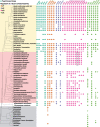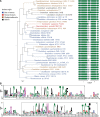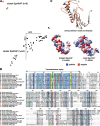From Root to Tips: Sporulation Evolution and Specialization in Bacillus subtilis and the Intestinal Pathogen Clostridioides difficile
- PMID: 31350897
- PMCID: PMC6878958
- DOI: 10.1093/molbev/msz175
From Root to Tips: Sporulation Evolution and Specialization in Bacillus subtilis and the Intestinal Pathogen Clostridioides difficile
Abstract
Bacteria of the Firmicutes phylum are able to enter a developmental pathway that culminates with the formation of highly resistant, dormant endospores. Endospores allow environmental persistence, dissemination and for pathogens, are also infection vehicles. In both the model Bacillus subtilis, an aerobic organism, and in the intestinal pathogen Clostridioides difficile, an obligate anaerobe, sporulation mobilizes hundreds of genes. Their expression is coordinated between the forespore and the mother cell, the two cells that participate in the process, and is kept in close register with the course of morphogenesis. The evolutionary mechanisms by which sporulation emerged and evolved in these two species, and more broadly across Firmicutes, remain largely unknown. Here, we trace the origin and evolution of sporulation using the genes known to be involved in the process in B. subtilis and C. difficile, and estimating their gain-loss dynamics in a comprehensive bacterial macroevolutionary framework. We show that sporulation evolution was driven by two major gene gain events, the first at the base of the Firmicutes and the second at the base of the B. subtilis group and within the Peptostreptococcaceae family, which includes C. difficile. We also show that early and late sporulation regulons have been coevolving and that sporulation genes entail greater innovation in B. subtilis with many Bacilli lineage-restricted genes. In contrast, C. difficile more often recruits new sporulation genes by horizontal gene transfer, which reflects both its highly mobile genome, the complexity of the gut microbiota, and an adjustment of sporulation to the gut ecosystem.
Keywords: bacterial genome evolution; horizontal gene transfer; sporulation; taxon-specific genes, Bacillus subtilis, Clostridioides difficile.
© The Author(s) 2019. Published by Oxford University Press on behalf of the Society for Molecular Biology and Evolution.
Figures









Similar articles
-
The spore differentiation pathway in the enteric pathogen Clostridium difficile.PLoS Genet. 2013;9(10):e1003782. doi: 10.1371/journal.pgen.1003782. Epub 2013 Oct 3. PLoS Genet. 2013. PMID: 24098139 Free PMC article.
-
Genome-wide analysis of cell type-specific gene transcription during spore formation in Clostridium difficile.PLoS Genet. 2013;9(10):e1003756. doi: 10.1371/journal.pgen.1003756. Epub 2013 Oct 3. PLoS Genet. 2013. PMID: 24098137 Free PMC article.
-
Identification of Functional Spo0A Residues Critical for Sporulation in Clostridioides difficile.J Mol Biol. 2022 Jul 15;434(13):167641. doi: 10.1016/j.jmb.2022.167641. Epub 2022 May 18. J Mol Biol. 2022. PMID: 35597553 Free PMC article.
-
Clostridium difficile spore biology: sporulation, germination, and spore structural proteins.Trends Microbiol. 2014 Jul;22(7):406-16. doi: 10.1016/j.tim.2014.04.003. Epub 2014 May 7. Trends Microbiol. 2014. PMID: 24814671 Free PMC article. Review.
-
The regulatory network controlling spore formation in Clostridium difficile.FEMS Microbiol Lett. 2014 Sep;358(1):1-10. doi: 10.1111/1574-6968.12540. Epub 2014 Aug 12. FEMS Microbiol Lett. 2014. PMID: 25048412 Review.
Cited by
-
Diversity and evolutionary dynamics of spore-coat proteins in spore-forming species of Bacillales.Microb Genom. 2020 Nov;6(11):mgen000451. doi: 10.1099/mgen.0.000451. Epub 2020 Oct 14. Microb Genom. 2020. PMID: 33052805 Free PMC article.
-
Multiple roads lead to Rome: unique morphology and chemistry of endospores, exospores, myxospores, cysts and akinetes in bacteria.Microbiology (Reading). 2023 Feb;169(2):001299. doi: 10.1099/mic.0.001299. Microbiology (Reading). 2023. PMID: 36804869 Free PMC article.
-
Global insights into the genome dynamics of Clostridioides difficile associated with antimicrobial resistance, virulence, and genomic adaptations among clonal lineages.Front Cell Infect Microbiol. 2025 Jan 15;14:1493225. doi: 10.3389/fcimb.2024.1493225. eCollection 2024. Front Cell Infect Microbiol. 2025. PMID: 39882343 Free PMC article.
-
SpoIIIL is a forespore factor required for efficient cell-cell signalling during Bacillus subtilis sporulation.PLoS Genet. 2025 Jul 3;21(7):e1011768. doi: 10.1371/journal.pgen.1011768. eCollection 2025 Jul. PLoS Genet. 2025. PMID: 40609071 Free PMC article.
-
Structural, Metabolic and Evolutionary Comparison of Bacterial Endospore and Exospore Formation.Front Microbiol. 2021 Mar 9;12:630573. doi: 10.3389/fmicb.2021.630573. eCollection 2021. Front Microbiol. 2021. PMID: 33767680 Free PMC article. Review.
References
Publication types
MeSH terms
LinkOut - more resources
Full Text Sources
Molecular Biology Databases

